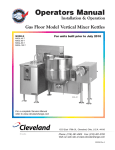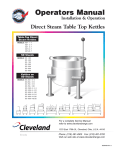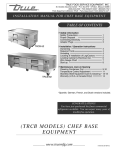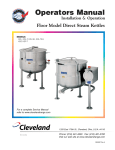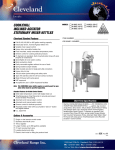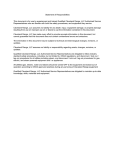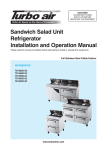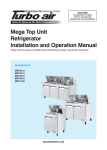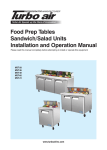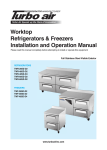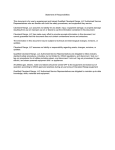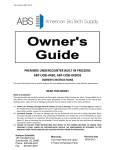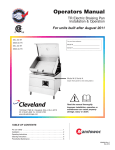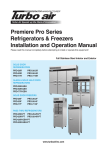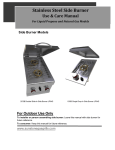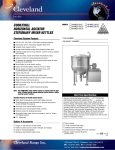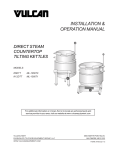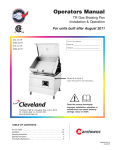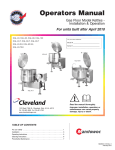Download SE95036 R6 (Kettle Floor Electric).qxp
Transcript
Operators Manual Installation & Operation Electric Floor Model Kettles For units built after August 1999 MODELS: KEL-25, KEL-30, KEL-40, KEL-40-SH, KEL-60, KEL-80, KEL-100 KEL-25-T, KEL-40-T, KEL-60-T, KEL-80-T, KEL-100-T KEL-40-SH, KEL-40-TSH, KEL-60-SH, KEL-60-TSH For a complete Service Manual refer to www.clevelandrange.com ™ Cleveland Enodis 1333 East 179th St., Cleveland, Ohio, U.S.A. 44110 Phone: (216) 481-4900 Fax: (216) 481-3782 Visit our web site at www.clevelandrange.com SE95036 Rev. 6 For your safety DANGER Keep clear of pressure relief discharge. Keep hands away from moving parts and pinch points. IMPORTANT Do not fill kettle above recommended level marked on outside of kettle. Inspect unit daily for proper operation. CAUTION Surfaces may be extremely hot! Use protective equipment. Wear protective equipment when discharging hot product. Do not lean on or place objects on kettle lip. Stand clear of product discharge path when discharging hot product. SERVICING Shut off power at main fuse disconnect prior to servicing. 0 Ensure kettle is at room temperature and pressure gauge is showing zero or less prior to removing any fittings. GAS APPLIANCES Do not attempt to operate this appliance during a power failure. Keep appliance and area free and clear of combustibles. INSTALLATION GENERAL Installation of the kettle must be accomplished by qualified electrical installation personnel working to all applicable local and national codes. Improper installation of product could cause injury or damage. This equipment is built to comply with applicable standards for manufacturers. Included among those approval agencies are: UL, NSF, ASME/Ntl. Bd., CSA, CGA, ETL, and others. Many local codes exist, and it is the responsibility of the owner/installer to comply with these codes. Note: Maximum voltage for LVD (low volt directive for Europe) to be 440 volts for CE marked appliances. CLEARANCE REQUIREMENTS & RECOMMENDED FLOOR DRAIN LOCATIONS Clearance Requirements Back Left Side Right Side * 0 0 12' * Minimum recommended clearance for service 2" Tangent Draw-Off Valve 2" Tangent Draw-Off Valve INSPECTION RECOMMENDED FLOOR DRAIN RECOMMENDED FLOOR DRAIN Before unpacking visually inspect the unit for evidence of damage during shipping. If damage is noticed, do not unpack the unit, follow Shipping Damage Instructions shown below. A A B B SHIPPING DAMAGE INSTRUCTIONS RECOMMENDED FLOOR DRAIN RECOMMENDED FLOOR DRAIN 12" x 12" C If shipping damage to the unit is discovered or suspected, observe the following guidelines in preparing a shipping damage claim. 1. Write down a description of the damage or the reason for suspecting damage as soon as it is discovered. This will help in filling out the claim forms later. C D D Tilting Models Stationary Models Recommended Floor Drain Locations ** Model # A B C D 2. As soon as damage is discovered or suspected, notify the carrier that delivered the shipment. KEL-25 22 3/8” 34” 5 1/4” 11 1/4” KEL-30 25 3/8” 37” 6 3/4” 12 3/4” 3. Arrange for the carrier's representative to examine the damage. KEL-40 28 5/8” 40” 7 3/4” 13 3/4” KEL-40-SH 32 1/2” 44” 9 1/2” 15 1/2” 4. Fill out all carrier claims forms and have the examining carrier sign and date each form. KEL-60 32 1/2” 44” 9 1/2” 15 1/2” KEL-80 35 7/8” 47” 11 1/4” 17 1/4” KEL-100 38 3/8” 50” 12 1/2” 18 1/2” KEL-25-T 22 1/4” 51 3/4” 4 24” INSTALLATION The first installation step is to refer to the Specification Sheets or Specification Drawings for detailed clearance and drain requirements in order to determine the location of the kettle. Next, carefully cut open the shipping carton for easy removal of the kettle. KEL-40-T 26 56 5 1/2” 28 1/2” KEL-60-T 29 3/4” 62 1/2” 5 1/2” 31” KEL-80-T 30 1/2” 65 3/8” 5 1/2” 35 1/2” KEL-100-T 34 1/8” 69 1/4” 4” 40 1/2” ** Above dimensions apply to standard 2" Tangent Draw-Off Valve only. For other valves consult factory. RED YELLOW BLACK 4" MINIMUM, 6" RECOMMENDED RED BLACK SINGLE PHASE BLUE RED THREE PHASE BLACK RECOMMENDED FLOOR FLOOR SLOPE DRAIN 1" IN 4' Note: Maximum voltage for LVD (low voltage directive for Europe) to be 440 volts for CE marked appliances. BLUE RECOMMENDED FLOOR DRAIN DETAIL RED YELLOW BLACK PIPE DRAIN RECOMMENDED MINIMUM VALVE SIZE PLUS 1" L1 L2 L3 L1 L2 The kettle is wired for 3-phase operation at the factory. For single phase operation, rewire the terminal block to that shown in the above diagram. ASSEMBLY Note: Ensure main power is turned off before connecting wires. FLANGED FOOT (5" DIA) 3 1/8" (3) 7/16" DIA. HOLES Flanged Foot Detail Position the kettle in it's permanent location, and level the kettle by turning the adjustable flanged feet. Once positioned and leveled, permanently secure the kettle's flanged feet to the floor using 5/16" lag bolts and floor anchors (supplied by the installer). There are three bolts required to secure each of the flanged feet. WIRE CONNECTION Install in accordance with local codes and/or the National Electric Code ANSI/NFPA No. 70-1990 (USA) or the Canadian Electric Code CSA Standard C22.1 (Canada). A separate fused disconnect switch must be supplied and installed. The kettle must be electrically grounded by the installer. The electrical supply must match the power requirements specified on the kettle's rating plate. The copper wiring must be adequate to carry the required current at the rated voltage. Stationary Models Remove the screws securing the dome-shaped service cover underneath the kettle and remove the cover. A wiring diagram is affixed to the inside of cover. Fasten permanent copper wiring to the three-connection terminal block, Be sure to connect ground wire to the separate ground terminal connector (ground lug). Slide the cover's slot over the wiring and secure the cover to kettle with the screws. Tilting Models First remove the handwheel by loosening the allen screw. Then remove the two screws at the front and rear of the console cover and remove the cover. A wiring diagram is affixed to the underside of the console cover. Feed permanent copper wiring through the cut-out in the bottom of the console, and fasten to the three-connection terminal block. Be sure to connect the ground terminal connector (ground lug). Replace the console cover and handwheel. WATER The sealed jacket of the electric kettle is precharged with the correct amount of a waterbased formula, and therefore, no water connection is required to the kettle jacket. The kettle can be equipped with optional hot and cold water taps, the taps require 1/2" copper tubing as supply lines. INSTALLATION CHECKS Although the kettle has been thoroughly tested before leaving the factory, the installer is responsible for ensuring the proper operation of kettle once installed. Visual Checks 1. Check Tilting (tilting kettles): A/ Gearbox tilts kettle smoothly and freely. 2. Insure there are: 5. Raise the kettle to the upright position. The Low Water Indicator Light (Red) (3) should go out when the kettle is upright. 6. Turn the ON/OFF Switch/Solid State Temperature Control (1) to "10" (Max.) and allow the kettle to preheat. The green light should remain on until the set temperature (260°F/127°C) is reached. Then the green light will cycle ON and OFF, indicating the element is cycling ON and OFF to maintain temperature. Fill the kettle with cold water to the steam jacket’s welded seam. Refer to the Temperature Range Chart for the time required to bring the water to a boil. A/ Three lag bolts securely holding each foot B/ The bottom cover (stationary kettles) is in place and held with a nut. 7. When all testing is complete, empty the kettle and turn the ON/OFF Switch/Solid State Temperature Control (1) to the “OFF” position. C/ The console cover (tilting kettles) is in place and held with a screw. CLEANING Performance Checks 1. Supply power to the kettle by placing the 150 200 100 30 10 300 40 0 IR NT A VE 0 250 20 50 50 60 psi 350 400 kPa fused disconnect switch to the "ON" position. 2. Before turning the kettle on, read the Vacuum/Pressure Gauge (4). The gauge's needle should be in the green zone. If the needle is in the "VENT AIR" zone, follow Kettle Venting Procedure in the Service Manual. 3. Turn the kettle's ON/OFF Switch/Solid State Temperature Control (1) to "1" (Min.). The Heat Indicator Light (Green) (2) should remain lit, indicating the element is on, until the set temperature is reached (130°F/54°C). Then the green light will cycle on and off, indicating the element is cycling on and off to maintain temperature. 4. Tilt the kettle forward (tilting models only). After a few moments the Low Water Indicator Light (Red) (3) should be lit when the kettle is in a tilted position. This light indicates that the element has automatically been shut off by the kettle's safety circuit. This is a normal condition when the kettle is in a tilted position. After installation the kettle must be thoroughly cleaned and sanitized prior to cooking. OPERATING INSTRUCTIONS CONTROL PANEL 6 5 7 4 8 3 9 3. 2 1 10 OFF 1. 4. 5. KE95555-2-A 4. 5. 2. 6. 8. 8. CONTROL PANEL TILTING KETTLE STATIONARY KETTLE General Parts Drawing ITEM # DESCRIPTION FUNCTION 1. On-Off Switch/Solid State Temperature Control Turns kettle ON/OFF and allows the operator to adjust the kettle temperature in increments from 1 (Min.) to 10 (Max.). (see Temperature Range Chart in the Operating Instructions section). 2. Heat Indicator Light (Green) When lit, indicates that the kettle element is on. Cycles ON-OFF with element. 3. Low Water Indicator Light (Red) When lit, indicates that the kettle is low on water and will not operate in this condition. This will also light when the kettle is tilted. 4. Vacuum/Pressure Gauge Indicate steam pressure in PSI inside steam jacket as well as vacuum in inches of mercury. 5. Pressure Relief Valve (not shown) This valve is used to vent the kettle and in the unlikely event there is an excess steam build-up in the jacket, this valve opens automatically to relieve this pressure. 6. Tilt Wheel Used for tilting the kettle up or down. Some units have an optional Power Tilt Control Switch located in the same position. 7. Power Tilt Control Switch (not shown) Used for tilting the kettle up or down. 8. Tangent Draw-Off Valve Used for draining product or wash water from kettle. It is supplied as standard equipment on stationary kettles and is optional on tilting kettles. OPERATING THE KETTLE DO NOT LEAN ON OR PLACE OBJECTS ON KETTLE LIP. SERIOUS INJURY COULD RESULT IF KETTLE TIPPED OVER, SPILLING HOT CONTENTS. 1. Before turning kettle on, read the Vacuum/Pressure Gauge (4). The gauges needle should be in the green zone. Once heated, the kettle's normal maximum operating pressure is approximately 10-12 psi, while cooking a water base product. 2. Ensure that the electrical service to the kettle is turned on at the fused disconnect switch. Temperature Control Setting Approximate Product Temperature °F °C 1. (Min.) 130 54 2. 145 63 3. 160 71 4. 170 77 5. 185 85 6. 195 91 7. 210 99 8. 230 110 9. 10. (Max.) 245 260 118 127 NOTE: Certain combinations of ingredients will result in temperature variations Temperature Range Chart 3. Preheat the kettle by turning the ON/OFF Switch/Solid State Temperature Control (1) to the desired temperature setting (see above "Temperature Range Chart"). The Heat Indicator Light (Green) (2) will remain lit, indicating the burner is lit, until the temperature setting is reached. When the green light goes off, the heaters are off, and preheating is complete. NOTE: When cooking egg and milk products, the kettle should not be preheated, as products of this nature adhere to hot cooking surfaces. These types of food should be placed in the kettle before heating is begun. 4. Place food product into the kettle. The Heat Indicator Light (Green) (2) will cycle on and off indicating the elements are cycling on and off to maintain the set temperature. NOTE: Do not fill kettle above recommended level marked on outside of kettle. NOTE: The Low Water Indicator Light (Red) (3) should not be lit when kettle is in upright position during operation. This light indicates that the elements have been automatically shut off by the kettle's safety circuit. It is, however, normal for the red light to come on when the kettle is in a tilted position. 5. When cooking is completed place ON/OFF Switch/Solid State Temperature Control (1) to the "OFF' position. 6. Pour the contents of the kettle into an appropriate container by tilting the kettle forward. Care should be taken to pour slowly enough to avoid splashing off the product. NOTE: As with cleaning food soil from any cookware, an important part of kettle cleaning is to prevent food from drying on. For this reason, cleaning should be completed immediately after cooked foods are removed. APPROXIMATE BOILING TIMES Times in Minutes Gals. 25 40 60 80 100 Ltrs. 95 150 225 300 375 Standard Wattage High Wattage* 208V 240V 480V 208V 240V 480V 60 60 100 130 160 45 50 75 100 120 60 75 75 100 120 40 40 50 65 80 30 30 40 50 60 30 30 40 50 60 *High Wattage is only available with 3 phase units. The accompanying chart shows approximate times required for electric kettles of various capacities to boil water. The ON/OFF Switch/Solid State Temperature Control (1) must be set at "10" (Max.) throughout the heatup period. Water will boil about 1/3 faster if the kettle is filled only to the outer steam jacket's welded seam, resulting in a kettle filled to 2/3 capacity. CLEANING INSTRUCTIONS CAUTION SURFACES MAY BE EXTREMELY HOT! CARE AND CLEANING Cooking equipment must be cleaned regularly to maintain its fast, efficient cooking performance and to ensure its continued safe, reliable operation. The best time to clean is shortly after each use (allow unit to cool to a safe temperature). CLEANING INSTRUCTIONS 1. Turn unit off. 2. Remove drain screen (if applicable). Thoroughly wash and rinse the screen either in a sink or a dishwasher. 3. Prepare a warm water and mild detergent solution in the unit. 4. Remove food soil using a nylon brush. 5. Loosen food which is stuck by allowing it to soak at a low temperature setting. 6. Drain unit. WARNINGS ➩ 7. Rinse interior thoroughly. Do not use detergents or cleansers that are chloride based or contain quaternary salt. Chloride Cleaners ➩ Do not use a metal bristle brush or scraper. 8. If the unit is equipped with a Tangent Draw-Off Valve, clean as follows: a) Disassemble the draw-off valve first by turning the valve knob counter-clockwise, then turning the large hex nut counter-clockwise until the valve stem is free of the valve body. b) In a sink, wash and rinse the inside of the valve body using a nylon brush. c) Use a nylon brush to clean tangent draw-off tube. d) Rinse with fresh water. e) Reassemble the draw-off valve by reversing the procedure for disassembly. The valve's hex nut should be hand tight only. Wire Brush & ➩ Steel wool should never be used for cleaning the stainless steel. 9. If the unit is equipped with a Butterfly Valve, clean as follows: a) Place valve in open position. b) Wash using a warm water and mild detergent solution. Steel Pads c) Remove food deposits using a nylon brush. ➩ Unit should never be cleaned with a high pressure spray hose. d) Rinse with fresh water. e) Leave valve open when unit is not in use. 10. Using mild soapy water and a damp sponge, wash the exterior, rinse, and dry. NOTES High Pressure Spray Hose ➩ Do not leave water sitting in unit when not in use. ➩ For more difficult cleaning applications one of the following can be used: alcohol, baking soda, vinegar, or a solution of ammonia in water. ➩ Leave the cover off when the kettle is not in use. Stagnant Water ➩ For more detailed instructions refer to the Nafem Stainless Steel Equipment Care and Cleaning manual (supplied with unit). STAINLESS STEEL EQUIPMENT CARE AND CLEANING (Suppied courtesy of Nafem. For more information visit their web site at www.nafem.org) Contrary to popular belief, stainless steels ARE susceptible to rusting. 4. Treat your water. Though this is not always practical, softening hard water can do much to reduce deposits. There are certain filters that can be installed to remove distasteful and corrosive elements. To insure proper water treatment, call a treatment specialist. Corrosion on metals is everywhere. It is recognized quickly on iron and steel as unsightly yellow/orange rust. Such metals are called “active” because they actively corrode in a natural environment when their atoms combine with oxygen to form rust. Stainless steels are passive metals because they contain other metals, like chromium, nickel and manganese that stabilize the atoms. 400 series stainless steels are called ferritic, contain chromium, and are magnetic; 300 series stainless steels are called austenitic, contain chromium and nickel; and 200 series stainless, also austenitic, contains manganese, nitrogen and carbon. Austenitic types of stainless are not magnetic, and generally provide greater resistance to corrosion than ferritic types. With 12-30 percent chromium, an invisible passive film covers the steel’s surface acting as a shield against corrosion. As long as the film is intact and not broken or contaminated, the metal is passive and stain-less. If the passive film of stainless steel has been broken, equipment starts to corrode. At its end, it rusts. 5. Keep your food equipment clean. Use alkaline, alkaline chlorinated or non-chloride cleaners at recommended strength. Clean frequently to avoid build-up of hard, stubborn stains. If you boil water in stainless steel equipment, remember the single most likely cause of damage is chlorides in the water. Heating cleaners that contain chlorides have a similar effect. 6. Rinse, rinse, rinse. If chlorinated cleaners are used, rinse and wipe equipment and supplies dry immediately. The sooner you wipe off standing water, especially when it contains cleaning agents, the better. After wiping equipment down, allow it to air dry; oxygen helps maintain the stainless steel’s passivity film. Enemies of Stainless Steel There are three basic things which can break down stainless steel’s passivity layer and allow corrosion to occur. 7. Never use hydrochloric acid (muriatic acid) on stainless steel. 8. Regularly restore/passivate stainless steel. 1. Mechanical abrasion 2. Deposits and water Recommended cleaners for specific situations 3. Chlorides Job Cleaning Agent Comments Mechanical abrasion means those things that will scratch a steel surface. Steel pads, wire brushes and scrapers are prime examples. Routine cleaning Soap, ammonia, detergent, Medallion Apply with cloth or sponge Fingerprints & smears Arcal 20, Lac-O-Nu Ecoshine Provides barrier film Stubborn stains & discoloration Cameo, Talc, Zud, First Impression Rub in direction of polish lines Grease & fatty acids, blood, burnt-on-foods Easy-off, De-Grease It Oven Aid Excellent removal on all finishes Grease & oil Any good commercial detergent Apply with sponge or cloth Restoration/Passivation Benefit, Super Sheen Water comes out of the faucet in varying degrees of hardness. Depending on what part of the country you live in, you may have hard or soft water. Hard water may leave spots, and when heated leave deposits behind that if left to sit, will break down the passive layer and rust stainless steel. Other deposits from food preparation and service must be properly removed. Chlorides are found nearly everywhere. They are in water, food and table salt. One of the worst chloride perpetrators can come from household and industrial cleaners. So what does all this mean? Don’t Despair! Here are a few steps that can help prevent stainless steel rust. 1. Use the proper tools. When cleaning stainless steel products, use non-abrasive tools. Soft cloths and plastic scouring pads will not harm steel’s passive layer. Stainless steel pads also can be used but the scrubbing motion must be in the direction of the manufacturers’ polishing marks. 2. Clean with the polish lines. Some stainless steel comes with visible polishing lines or “grain.” When visible lines are present, always scrub in a motion parallel to the lines. When the grain cannot be seen, play it safe and use a soft cloth or plastic scouring pad. Review 1. Stainless steels rust when passivity (film-shield) breaks down as a result of scrapes, scratches, deposits and chlorides. 2. Stainless steel rust starts with pits and cracks. 3. Use the proper tools. Do not use steel pads, wire brushes or scrapers to clean stainless steel. 4. Use non-chlorinated cleaners at recommended concentrations. Use only chloride- free cleaners. 5. Soften your water. Use filters and softeners whenever possible. 6. Wipe off cleaning agent(s) and standing water as soon as possible. Prolonged contact causes eventual problems. 3. Use alkaline, alkaline chlorinated or non-chloride containing cleaners. While many traditional cleaners are loaded with chlorides, the industry is providing an ever-increasing choice of non-chloride cleaners. If you are not sure of chloride content in the cleaner used, contact your cleaner supplier. If your present cleaner contains chlorides, ask your supplier if they have an alternative. Avoid cleaners containing quaternary salts; it also can attack stainless steel and cause pitting and rusting. To learn more about chloride-stress corrosion and how to prevent it, contact the equipment manufacturer or cleaning materials supplier. Developed by Packer Engineering, Naperville, Ill., an independent testing laboratory. MAINTENANCE ALL SERVICE MUST BE PERFORMED BY A QUALIFIED SERVICE TECHNICIAN. IMPORTANT! ENSURE KETTLE IS AT ROOM TEMPERATURE AND PRESSURE GAUGE IS SHOWING ZERO OR LESS PRESSURE PRIOR TO REMOVING ANY FITTINGS. Cleveland Range equipment requires little preventative maintenance. We do however provide the following chart as a guideline for inspection and maintenance to keep your unit functioning at 100%. INSPECTION AND MAINTENANCE CHECK LIST The following check should be completed every six months or more frequently if unit is in a high volume facility. WARNING: It is imperative that damaged seals be repaired immediately to prevent equipment failure and/or damage. ITEM CHECK BOTTOM COVER GASKETS Check to see both gaskets are in place and are not cracked or split. Kettle Bottom Gaskets CONSOLE COVER Insure there are two screws firmly holding down the cover. If not replace screws. HAND WHEEL (hand tilt models only) Check hand wheel for tightness. If loose tighten allen screw. TILTING Check that kettle tilts smoothly. Grease as described in LUBRICATION PROCEDURE. (tilting models only) PRESSURE GAUGE Check that the gauge does not have moisture on its inside face. Replace if moisture is present. Check that the gauge shows a vacuum (needle is well into the Green zone) when cold and shows between 25-40 psi when unit is hot. If not follow VACUUM LEAK TEST PROCEDURE. PRESSURE RELIEF VALVE Check pressure relief valve as described in PRESSURE RELIEF VALVE TESTING PROCEDURE. TEMPERATURE CHECK Following CALIBRATING PROCEDURE check the inner kettle surface temperature with a digital surface thermometer and adjust if required. Kettle Safety Inspection Checklist Just recently a competitor’s steam jacketed kettle exploded causing serious personal injury and damage to a kitchen. In most cases these accidents are caused by poor maintenance and/or incorrect installation. We at Cleveland would like to restate that regular inspection and maintenance of units is essential to obtain trouble free and safe operation of equipment. Inspections must include testing of the pressure relief valve and checks of the operating system to insure that it has not been altered. No safety features designed into the equipment should ever be tampered with. Tampering with or bypassing controls is a very dangerous practice and unfortunately we have seen several cases of this. Following is a short list of the most common and the most dangerous alterations performed on kettles. SAFETY VALVE: 1 ✘ Plug ✔ ✔ ✔ ✔ 2 The above illustrations show the three variations of factory installed Safety Valves. Any modifications are unacceptable. Incorrect Installations 1 Safety valve has plug threaded into the discharge opening preventing any steam from escaping. 2 Safety valve’s tube diameter has been reduced. 3 Safety valve is sticking, frozen shut or plugged. To test, refer to Service Bulletin SE90038 rev. 2, “Pressure Relief Valve Periodic Testing”. 4 Safety valve is plumbed to a drain or water line creating back pressure and reducing flow. 3 ✘ Tube diameter reduced ✘ Frozen, stuck, or plugged ✘ 4 Plumbed to drain or water line SE90047 SAFETY THERMOSTAT: 1 ✔ Probe fully inserted in tube Wiring is properly connected ✘ Probe removed partially Incorrect Installations 2 ✘ Probe removed completely 3 ✘ Thermostat electrically bypassed 1 Safety thermostat probe is not completely inserted into tubing. 2 Safety thermostat probe is removed from tubing. 3 Safety thermostat electrical connection is bypassed. Low Water Level Probe: (A) (B) ✔ Probe properly attached ✘ Probe bypassed by running (A) an additional wire Operating Thermostat: 265º ✔ 260º - 270º MAXIMUM KETTLE TEMPERATURE If maximum temperature is not in this range (on empty kettle), refer to the “Calibrating Procedure” in the unit’s Installation, Operation & Service Manual. ✘ Probe bypassed by (B) grounding the connecting wire LUBRICATION PROCEDURE Lubricate the following parts every three months to insure smooth operation and reduce wear. 3/8" Allen wrench TRUNNION HOUSING, WORM SCREW AND TILT GEAR Adjusting Screw Worm Screw and Tilt Gear Cross Bar These parts are accessed through the top cover of the console. Apply grease to gear teeth. Check for excessive play and adjust with adjusting screw located on top of cross bar. Trunnion Housing Grease Nipple HINGE ADJUSTMENT INSTRUCTIONS KETTLE TRUNNIONS On the left hand side of the kettle there are two grease nipples on the top back portion of the trunnion housing. On the right hand side of the kettle you must remove the console cover to access the grease nipple. 1. 2. 3. 4. 5. 6. 7. 8. 9. 10. Insert 3/8" Allen wrench. Turn clockwise to relieve tension on spring. While tension is released remove one of the two slotted screws. To prevent Allen wrench from springing back abruptly while the second slotted screw is removed, insert a pin (approximately 1/8") in the hole where the first slotted screw was removed from. Remove second slotted screw. While holding Allen wrench remove pin. Turn Allen wrench clockwise to tighten or counter-clockwise to loosen tension to produce desired effect. Re-insert pin in one of the two holes. Tighten one slotted screw in the other hole (it may be necessary to turn Allen wrench slightly to align holes). Remove pin and repeat step number 9. for other slotted screw.













